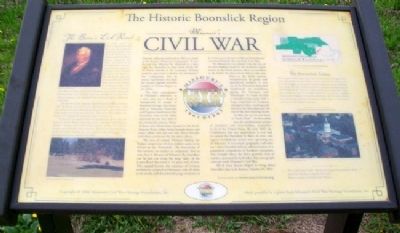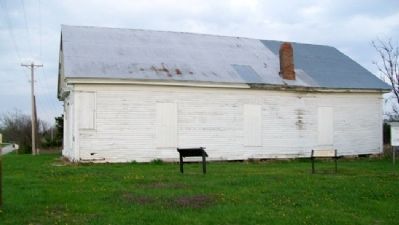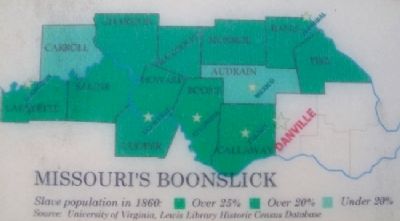Danville in Montgomery County, Missouri — The American Midwest (Upper Plains)
The Historic Boonslick Region
Missouri's Civil War
Missouri achieved statehood in 1821 as a result of the famous "Missouri Compromise." It was decreed that Missouri be admitted as a slave state, but thereafter no state north of the 36º 30' North latitude in the Louisiana Territory would be permitted to harbor the ["]institution." The Compromise left an uneasy equilibrium that kept the country together until the troubles in Kansas began in the 1850s.
The first consequence of Missouri's admission as a slave state was a flood of immigration by people of Southern heritage, from states such as Tennessee, Kentucky and Virginia. Southerners, like Easterners, were on the move westward in the first half of the nineteenth century. Many of these new Missourians located in the fertile Missouri River valley. Some brought slaves, and many others who did not own slaves brought with them a tolerance for the slave culture.
The area of central Missouri having the highest proportion of slave-holders came to be known as the "Boonslick." The boundaries of this territory are subject to conjecture, then as now, but in this part of Missouri the boundary can be laid out along the deep valley of the Loutre River that exists 2½ miles west of here. This natural barrier, the existene of German settlements centered at Hermann, only 15 miles to the south, and of a railroad tying commerce to St. Louis, just to the east, would turn Danville into a no-man's land by the end of the Civil War.
The Boonslick was isolated from the rest of the slave-holding South by the mountain region known as the Ozark plateau, where (as elsewhere in the South) the slave culture did not take root. Even as the 1860s arrived, transportation of goods and agricultural products in and out of the Boonslick depended inordinately on steamboats plying the Missouri and Mississippi. St. Louis, by then a manufacturing center with a large proportion of European immigrant labor, stood squarely between the Boonslick and the rest of the slave-holding South.
In 1861, the area we now know as "Little Dixie" - the Boonslick - was the northernmost pocket of Southern and slave-holding sympathies in all of the United States. By early 1862, the Confederacy lost any opportunity it ever had to control the Boonslick by force of arms, and regular Confederate armies were operating out of Arkansas. It was simple geography, and some say a heavy-handed military administration of a population sympathetic to Southern viewpoints, that brought about the fierce guerrilla style of warfare, practiced by both sides, that most people associate with Missouri's Civil War.
All of these factors helped to bring about Danville's date with destiny, October 14, 1864.
Learn more at www.mocivilwar.org
The
Boone's Lick Road
In 1799, Daniel and Rebecca Boone moved from Kentucy and established a home in St. Charles County, Missouri. Their grown sons, Nathan and Daniel Morgan Boone, emigrated with them. Two sources of salt were discovered to the west, north of the Missouri River - "salt licks", which referred to the practice of wild game to lick salt deposits appearing at the ground surface. One of these sources was acquired by the Boone brothers, and hence was known as Boone's Lick. The road which connected St. Charles to these sources became the Boonslick Road. Later, the entire region that straddled the Missouri River came to be known as the Boonslick. Now, it is better known as Missouri's "Little Dixie."
The Boonslick Road originally ended in Howard County, Missouri, where the Boones' salt works is now a Missouri State Historic Site. After this road was extended westward from Howard County, the old Boonslick Road would become the Santa Fe Trail. This ancient thoroughfare later became U.S. Highway 40 and finally modern Interstate 70.
The portrait that appears above was painted from life in 1820, the same year Daniel Boone passed away at his son's home near Defiance, Missouri. The home still stands 45 miles southeast of here, in St. Charles County, and is a popular visitors attraction. The artist is Chester Harding, whose son Chester Harding, Jr. was
a colonel in the Union army who figured prominently in Missouri's Civil War.
The Boonslick Today
The historic Boonslick region today reflects a rich mixture of its agricultural roots with educational and cultural activities to draw the attention of the entire Midwest. At the center is the growing urban area of Columbia, home of the University of Missouri, the first land-grant institution west of the Mississippi River. Festivals, art shows and farmers markets draw visitors from around the state to Columbia, which has also become a regional shopping hub. Rocheport, Boonville and Fayette to the west and northwest each offer unique attraction for history-minded visitors, as do Centralia and Fulton to the northeast and east.
Erected 2006 by Missouri's Civil War Heritage Foundation, Inc.
Topics and series. This historical marker is listed in these topic lists: Industry & Commerce • Patriots & Patriotism • Settlements & Settlers • War, US Civil. In addition, it is included in the Missouri’s Civil War series list. A significant historical date for this entry is October 14, 1917.
Location. 38° 54.511′ N, 91° 32.084′ W. Marker is in Danville, Missouri, in Montgomery County. Marker is at the intersection of Missouri Route 161 and Boonslick Road, on the right when traveling east on State Route 161. Touch for map. Marker is in this post office area: Montgomery City MO 63361, United States of America. Touch for directions.
Other nearby markers. At least 8 other markers are within 9 miles of this marker, measured as the crow flies. Danville Female Academy (here, next to this marker); Archaeology of the Cave (approx. 2.2 miles away); Exploring the Past (approx. 2.2 miles away); Davault Tavern - 1828 (approx. 4½ miles away); Montgomery City Veterans Memorial (approx. 4.6 miles away); Montgomery County War Memorial (approx. 5.1 miles away); Lewiston - 1826 (approx. 7.3 miles away); Gateway to the Boone's Lick (approx. 9 miles away).
Also see . . .
1. Daniel Morgan Boone. Historic Missourian website entry (Submitted on July 6, 2011, by William Fischer, Jr. of Scranton, Pennsylvania.)
2. The Boone Society. Society website homepage (Submitted on July 6, 2011, by William Fischer, Jr. of Scranton, Pennsylvania.)
3. Boone's Lick Road Association. Association website homepage (Submitted on February 22, 2022, by Larry Gertner of New York, New York.)
4. Boonslick Regional Planning Commission. (Submitted on July 6, 2011, by William Fischer, Jr. of Scranton, Pennsylvania.)
Credits. This page was last revised on February 22, 2022. It was originally submitted on July 6, 2011, by William Fischer, Jr. of Scranton, Pennsylvania. This page has been viewed 1,090 times since then and 41 times this year. Photos: 1, 2, 3. submitted on July 6, 2011, by William Fischer, Jr. of Scranton, Pennsylvania.


